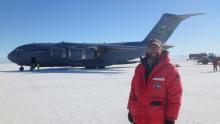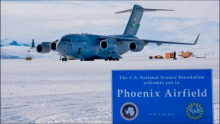What Are They Doing?
 Pressure ridges form ice formations on the Ross Ice Shelf, Antarctica. Photo by Gary Wesche.
Pressure ridges form ice formations on the Ross Ice Shelf, Antarctica. Photo by Gary Wesche.
The objective of our project is to understand the behavior of the McMurdo Shear Zone (SZ) in Antarctica through a four year integrated study involving field observation, satellite remote sensing, and numerical modeling. The SZ is a section of heavily crevassed ice that separates the slow-moving McMurdo Ice Shelf (MIS) from the larger fast-flowing Ross Ice Shelf (RIS). Previous mapping of crevasses in the SZ indicates the potential for unstable behavior. Our project will carry out GPS surveys to study the surface deformation across the SZ and Ground Penetrating Radar surveys (GPR) to obtain detailed maps of crevasse extent and orientation. Because the shear zone is intensely crevassed, and hence dangerous for surface travel, we will perform the GPR surveys using an autonomous robot. The field observations will be used to develop a numerical model of the shear zone’s behavior and simulate future scenarios of its influence on ice shelf stability.
The SZ provides a critical amount of lateral support for the RIS. A potential weakening of this area could reduce the amount of backstress provided by the RIS on inland ice which would increase the flux of ice across the grounding line and thereby accelerate the ice sheet’s contribution to sea level rise. Logistic support of the US Antarctic Program’s South Pole station also relies on an overland traverse from McMurdo which must cross the SZ. Our work will provide a means of predicting future SZ behavior and provide a timeframe to plan alternative routes if necessary.
Where Are They?
 A view of McMurdo Station, Antarctica. Photo by Michael League.
A view of McMurdo Station, Antarctica. Photo by Michael League.
Our camp is located on the edge of the McMurdo Shear Zone approximately 50 km from McMurdo Station. Living conditions include tent camping in extreme cold while in the field, and shared facilities while transiting McMurdo. Each group member has their own private tent for sleeping; two larger communal tents serve as a kitchen/gathering space, and scientific workshop. The teacher will participate in day to day camp chores including cooking, cleaning, field repairs, and vehicle maintenance. The only forms of communication at base camp are satellite phone and radio. However, there will be internet access at McMurdo Station before and after the time at field camp.
Latest Journals

Gordon Hamilton is a Professor with a joint appointment in the School of Earth and Climate Sciences and the Climate Change Institute at the University of Maine. Dr. Hamilton studies ice sheet mass balance and the role of ice sheets in modulating global sea levels. Current research focuses on understanding the dynamics of outlet glaciers and ice shelves in Greenland and Antarctica, ice-ocean interactions in Greenland, snow distribution across the polar ice sheets. This work involves field experiments, satellite remote sensing and numerical modeling. Prior to arriving at UMaine, he was a research scientist at Ohio State’s Byrd Polar Research Center and the Norwegian Polar Institute. He received his PhD in Geophysics from the University of Cambridge.

Researcher Lynn Kaluzienski is a PhD student at both the School of Earth and Climate Sciences and Climate Change Institute at the University of Maine. She received her Bachelor's of Science in Physics and Astronomy at Emory University in 2014. Since then she has strived to apply her background in physics to problems within the Cryosphere. She currently researches the dynamics of ice shelf margins and calving fronts and their effects on ice shelf stability.





